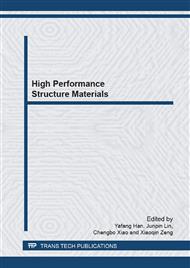p.654
p.659
p.665
p.672
p.678
p.684
p.690
p.697
p.703
Effects of Long-Term Aging Treatment on Stress Rupture Properties of FGH95 Ni-Base Superalloy
Abstract:
The effect of long-term aging on stress rupture properties was investigated by means of microstructure observation and properties measurement. The results show that, after long-term aging for 500 h at 723 K, the coarser particle-like γ phase is precipitated along the grain boundaries of alloy, significant amount of γ particles are regularly distributed within the grain. Moreover, some carbide particles precipitated depressively along the boundaries and within the grain. As the aged time and temperature increase, the size of fine γ particles in the alloy increases slightly, and the stress rupture property of the alloy decreases under the condition of 923K and 1034MPa. The deformation features of the alloy during creep are that the dislocations slip in the matrix or shear into the γ phase, the dislocations shearing into the γ phase may be decomposed to form the configuration of the two partial-dislocations plus stacking fault. As the creep goes on, the slipping traces with different orientations appear in the surface of the specimen, and some slipping steps are formed in the region near the boundaries, which may cause the stress concentration to promote the initiation and propagation of the cracks along the boundaries up to creep fracture.
Info:
Periodical:
Pages:
678-683
Citation:
Online since:
February 2013
Authors:
Price:
Сopyright:
© 2013 Trans Tech Publications Ltd. All Rights Reserved
Share:
Citation:


